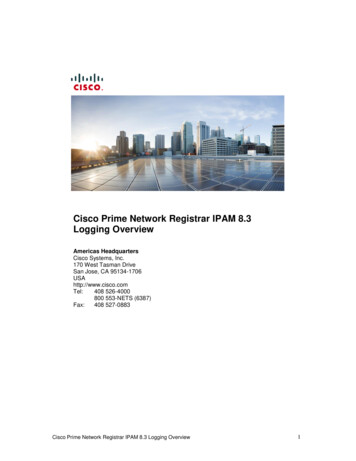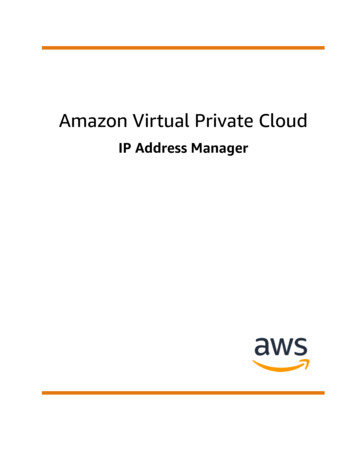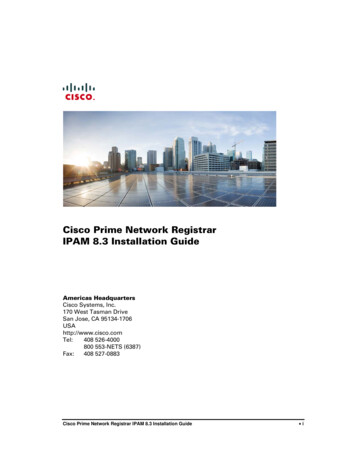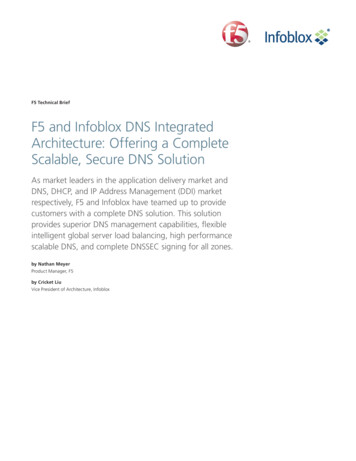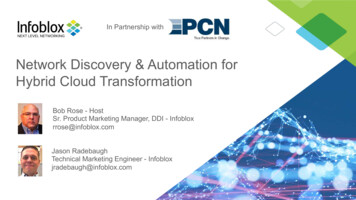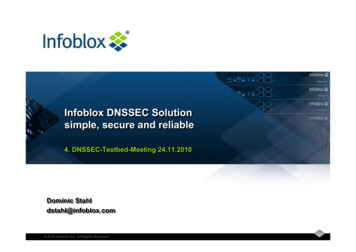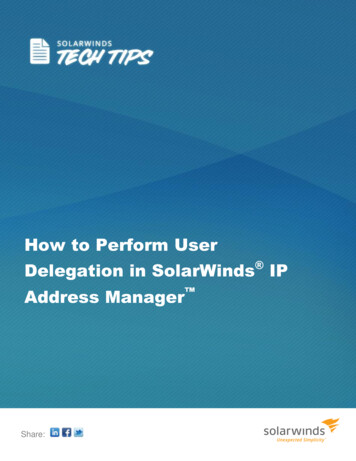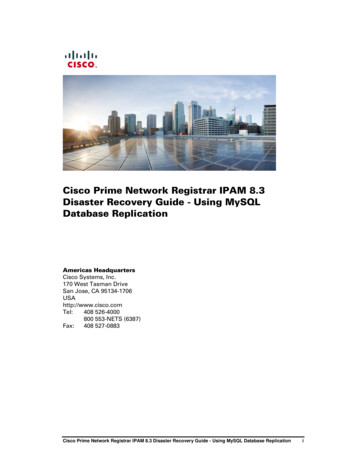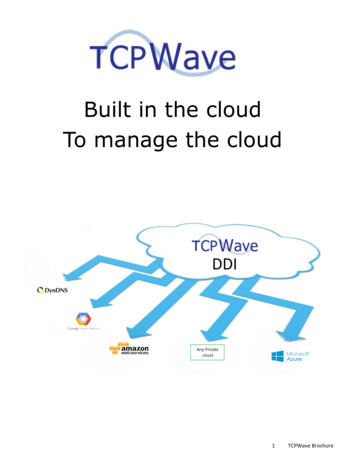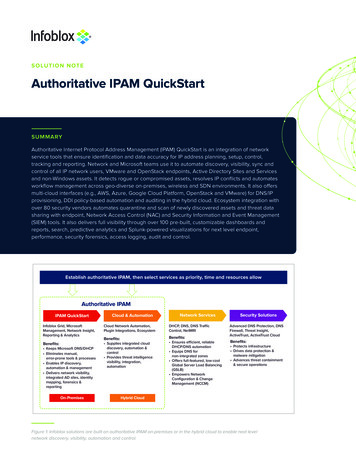
Transcription
SO LUTI O N N OTEAuthoritative IPAM QuickStartSUMMARYAuthoritative Internet Protocol Address Management (IPAM) QuickStart is an integration of networkservice tools that ensure identification and data accuracy for IP address planning, setup, control,tracking and reporting. Network and Microsoft teams use it to automate discovery, visibility, sync andcontrol of all IP network users, VMware and OpenStack endpoints, Active Directory Sites and Servicesand non-Windows assets. It detects rogue or compromised assets, resolves IP conflicts and automatesworkflow management across geo-diverse on-premises, wireless and SDN environments. It also offersmulti-cloud interfaces (e.g., AWS, Azure, Google Cloud Platform, OpenStack and VMware) for DNS/IPprovisioning, DDI policy-based automation and auditing in the hybrid cloud. Ecosystem integration withover 80 security vendors automates quarantine and scan of newly discovered assets and threat datasharing with endpoint, Network Access Control (NAC) and Security Information and Event Management(SIEM) tools. It also delivers full visibility through over 100 pre-built, customizable dashboards andreports, search, predictive analytics and Splunk-powered visualizations for next level endpoint,performance, security forensics, access logging, audit and control.Establish authoritative IPAM, then select services as priority, time and resources allowAuthoritative IPAMIPAM QuickStartCloud & AutomationNetwork ServicesInfoblox Grid, MicrosoftManagement, Network Insight,Reporting & AnalyticsCloud Network Automation,Plugin Integrations, EcosystemDHCP, DNS, DNS TrafficControl, NetMRIBenefits:Benefits:Benefits: Supplies integrated clouddiscovery, automation &control Provides threat intelligencevisibility, integration,automation Keeps Microsoft DNS/DHCP Eliminates manual,error-prone tools & processes Enables IP discovery,automation & management Delivers network visibility,integrated AD sites, identitymapping, forensics &reportingOn-Premises Ensures efficient, reliableDHCP/DNS automation Equips DNS fornon-integrated zones Offers full-featured, low-costGlobal Server Load Balancing(GSLB) Empowers NetworkConfiguration & ChangeManagement (NCCM)Security SolutionsAdvanced DNS Protection, DNSFirewall, Threat Insight,ActiveTrust, ActiveTrust CloudBenefits: Protects infrastructure Drives data protection &malware mitigation Advances threat containment& secure operationsHybrid CloudFigure 1: Infoblox solutions are built on authoritative IPAM on-premises or in the hybrid cloud to enable next levelnetwork discovery, visibility, automation and control.
Key Components Authoritative IPAMAutomatically delivers accurate visibility into network asset types, attributes, availability, user context,network activity, location, network type (on-premises, hybrid cloud, wired, wireless, SDN), topology,vendor infrastructure and more. Infoblox GridEmpowers physical, virtual or cloud-based DNS/DHCP/ IPAM (DDI) appliances embedded with IPAM,database and discovery of VMWare and OpenStack assets for reliable, automated, distributed,security-hardened, high availability and easy-to-manage core network services via a single paneof glass. Microsoft ManagementDelivers an agentless DDI overlay that retains Microsoft protocols but eliminates IP conflicts, DHCPand network outages, allowing full discovery of Microsoft network endpoints, Active Directory(AD) Sites and Services and user/IP mapping for visibility, automation, orchestration, cross-teamcollaboration, reporting and control. Network InsightEnables full, accurate and automated discovery, visibility, IPAM sync, switch port management, rogueand compromised asset detection, IP conflict resolution, reporting and analytics across geo-diverseon-premises, wireless and SDN environments for efficient, automated workflow management.Authoritative IPAM –Accuracy, Visibility and AutomationAuthoritative IPAM accurately reflects the state of your network, provides contextual visibility (i.e., the who,what, why, when, how, where and which) of your network assets (e.g., IP addresses, subnets or VLANs) andenables you to replace manual, error-prone tools and processes with efficient, automated workflows.Purpose –Ensuring network availability through accurate usage tracking of network assets was the original purposeof IPAM. If you allocate an IP address that is already in use, IP conflicts, network outages and escalationswill result. Authoritative IPAM is the only way to avoid these outcomes. Network, Microsoft/Server Ops andSecurity teams gain considerable benefit by simply knowing that all network asset data is accurate andvisible from a single console. Network Ops teams cannot perform proper capacity, asset/inventory or servicemanagement (e.g., ServiceNow) without having an accurate and complete view into the network. And Securityteams cannot secure what they can’t see. Authoritative IPAM is the solution.Accuracy –Authoritative IPAM ensures accuracy by comparing IPAM database records with the actual network state todetect discrepancies, provide notification, reports and automated, policy-based remediation. Rather thanmanual user inputs and tracking, authoritative IPAM uses end-to-end workload automation to identify whichassets are in use, and which are available for allocation.Visibility –Beyond access to the IP address and subnet information, authoritative IPAM identifies a wealth of endpointdata. You’ll know if the asset is a router, switch, firewall or end-host, the model, OS, vendor and which user isusing the asset. You’ll know when it appeared on the network and when it disappeared, and its exact locationincluding the subnet, wireless AP, switch port, ESXi host or AWS VPC. You’ll see if it’s on-premises, wired,wireless, SDN, private, or in the public or hybrid cloud. And you’ll have up-to-date insights on your ecosystem,infrastructure and network services vendors, no matter how complex or distributed. The end-result is thatyou’ll gain clear, near-real-time summary and detailed visibility of everything on your network despitecomplexity, diversity or location.
Key Components Cont. Cloud Network Automation and PluginsProvides multi-cloud inter- faces, (e.g., VMware, OpenStack, Azure, AWS) IPAM discovery andvisibility, DNS/IP provisioning, virtual server DDI policy-based automation, DDI auditing and reportingthrough a unified management interface. Ecosystem IntegrationAutomates quarantine and scans of newly discovered assets, near-real-time remediation andTrustSec policy via integrations with 80 security vendors (e.g., McAfee, Cisco, Carbon Black,FireEye, etc.) and threat data sharing with endpoint, Network Access Control (NAC) and SecurityInformation and Event Management (SIEM) tools. Reporting and AnalyticsDelivers full plug and play visibility through 100 pre-built, customizable dashboards and reports,search, predictive analytics and Splunk- powered visualizations for endpoint, performance, securityforensics, access logging, audit and control.Authoritative IPAMNetwork/MSEndpoint DiscoveryWhat IP and MACWhen AppearWhat Subnet/VLANDevice AttributesDNS RecordsUserWhere has it beenDHCP StatusEnsuring Accuracy****IPAMAutomated WorkflowsIP Address SyncAdd Networks/RangesAdd IPs/DNS RecordsNew (sync)New (sync or remediate)Drop Networks/RangesDrop IPs/DNS RecordsSwitch Port/AP toHost Configuration –Single Source of TruthInactive (report)Inactive (sync or report) –Conflict (sync)Figure 2: Infoblox authoritative IPAM, endpoint discovery, IP address sync and automatedworkflows deliver a single source of truth.Automation –When you possess an accurate database of record, opportunities for automation are extensive. It enablesautomated end-to-end workload provisioning, deprovisioning and DNS, DHCP and IPAM (DDI) componentsyncing, NAC end-host identification and quarantine, end-host vulnerability scanning, ecosystem inteland threat sharing, alerting, reporting, analytics and more. This delivers greater accuracy, reliability,processing speed and cross-team collaboration while enabling skilled workers to be redeployed tohigher-value assignments.
IPAM QuickStart – A Deeper LookIPAM QuickStart includes components you can select as your priorities, time and resources allow: Infoblox Grid – IP AddressManagement, database anddiscovery of VMware andOpenStack assets Microsoft Management –Discovery and managementof Microsoft DHCP and DNSenvironments Network Insight – Discovery ofon-premise wired, wireless andSDN environments Ecosystem – Outbound APIand outof-the-box Ecosystemintegrations Cloud Network Automation –Discovery of AWS, Azure,GGCP, OpenStack, VMware andadvanced plugins (e.g., Ansible,Docker, Kubernetes) Reporting and Analytics –Near-real-time and historicaldashboards, reports, alerts andpredictive analyticsInfoblox Discovery—Authoritative IPAM for Any PlatformThe Foundation of a Secured, Controlled NetworkSecure DNSNetwork Services (DDI)Network Automation IPs, MACs & Hostnames Network in-synch with IPAM Subnets & VLANs Remediate Rogue & CompromisedEnd Hosts Device and End Host Attributes Capacity Management When and Where Attached Asset Management User Context Security Compliance Enforcement Topology ViewsAny PlatformWiredWirelessSDNDHCPDNSAD Sites sesFigure 3: Infoblox authoritative IPAM works across Secure DNS, DDI and NetworkAutomation to integrate IPAM services for any platform.PublicPublic
Value of Authoritative IPAM—Security, Availability andTrue Database of RecordFunctionalTeamsNetwork OperationsMicrosoft/ServerSecurity OperationsValue DeliveredVisibility into currentand historical assetdata, inventory,management andcontrolVisibility, collaborationand control acrossdisparate MicrosoftDHCP/DNS serversand Active Directorydomain controllers froma single consoleConsolidated nearreal-time visibility intonetwork infrastructure,users, devices, DNSthreats, malicious events,contextual data, forensicsand data sharingQuestionsAnswered What networkdevices and hostsare on my network? Which DHCP IPaddresses are beingused, who is usingthem, where arethey on the networkand what types ofdevices are they? To which switch port orwireless access pointis this compromisedor rogue end-hostattached? What subnets,VLANs and IPaddresses are onmy network? How many freeswitch ports do Ihave? What’s in mydevice componentinventory? When did thesenetwork assetsappear and whereare they now? To which ESX hostand virtual switch isthis VM attached? To which Tenant,network and VPCdoes is this AWS VMattached? To which EPG,Tenant, and BridgeDomain is this endhost attached? When did the deviceusing this DNSrecord appear onthe network, whichVLAN is it on and towhich switch port isit attached? What are all myActive Directorydomains, which sitesare they found in andwhich subnets areused for replication? What networkdevices and hostsare on my network? Where has this endhost and user beenon the network for thepast 2 years? What new assets onthe network need tobe quarantined orscanned? What was discoveredthat we didn’tknow about? (i.e.,unmanaged assets)?
Summary: Infoblox Grid and IpamInfoblox Grid and IPAM enables network accuracy, visibility and reliability: Provides automatic accurate, reliable, near-real-time data updates and status of network assets (e.g.,IPs, subnets & VLANs) for visibility, control and guaranteed performance Detects discrepancies between the IPAM database and the true network state for alertingand remediation Allows distributed integrated appliances to deliver automated, highly available, security-hardened,easy-todeploy and manage core network services via a single pane of glassInfoblox Grid and IPAMInfoblox physical or virtual appliances deliver core network services in a reliable, secure, easy-to-deploy andmanage platform. The Infoblox Grid is created by linking appliances across a distributed enterprise. Ratherthan a separate management and reporting application overlay for individual appliances, Grid appliancesare embedded with a sophisticated distributed database technology and linked together. This transformsthe appliance network into a unified system with a single UI, high availability, hardened system security andintegrated DDI database.The Infoblox Grid simplifies and delivers IPAM as a manual or automated core network service for a moreresilient network while delivering significant labor, time and workflow savings. Applications that need IPaddresses can be served in a consistent, automated and error-free manner through the Infoblox IPAMinterface:Figure 4: The Infoblox UI maps IP address data for a given DHCP range anddelivers this information through a single management platform.
Summary: Infoblox MicrosoftManagementInfoblox Microsoft Management is a DNS/DHCP protocols overlay that retains existinginfrastructure and enhances investment:GridMemberGridMemberGrid Master Central DNS/DHCP integrationand managementMSRPC/DCOMMSRPC/DCOM Agentless connection with no server impact Automated DDI component syncing andnear-real-time 16 Cross-team collaboration User/IP identity-mapping Resource planningFigure 5: Infoblox Microsoft Management is an agentless overlay for MicrosoftDNS/ DHCP that solves IP conflicts, DHCP issues and network outages.Microsoft ManagementWith the skyrocketing demand for IP addresses fueled byever-increasing applications, personal devices, IoT, IPv6,virtualization and more, many organizations struggle tomanage IPs efficiently to ensure delivery of highly availablenetwork services. The struggle is worse for organizationspreferring to retain existing Microsoft-based DNS/DHCPservers, but find that more servers, added technology andan automated IPAM system are essential to keep pace withIP address management scalability, redundancy and securityneeds. Infoblox Microsoft Management solves thesechallenges. By keeping the existing Microsoft DNS/DHCPprotocols, Infoblox Microsoft Management provides a nonintrusive overlay to enhance the value of the existingMicrosoft investment. Since it uses RPC via DCOM forcommunication, no installed agents are required. AddingMicrosoft Management adds full visibility to solve IP conflicts,DHCP availability issues and network outages. Here are acouple of key use cases:DHCP info from MicrosoftFigure 6: Infoblox captures and displays DHCP datafrom Microsoft protocols.AD domainsSitesNetworks for site replicationAlso populatesUser dataHybrid Cloud, Central View of Microsoft DHCP:Infoblox can be used in the private, public or hybrid cloud.Due to its deep, DNS integration, you can access MicrosoftDHCP data to see things like address range, usage status,lease state and more, all from a central view:Hybrid Cloud, Central View of Microsoft Sitesand Services:Infoblox saves you time and makes your job easier bycapturing Microsoft Active Directory domains, Sites, networksfor replication, user data and more, bringing it all togetherin a single view:Figure 7: Infoblox Microsoft Management captures and presentsMicrosoft Sites and Services data through a central view.
Summary: Infoblox NetworkInsightInfoblox Network Insight delivers on-premisesdiscovery, visibility, IPAM sync, switch portmanagement and control: Unveils deep discovery of network devices,end-hosts, subnets, interfaces, componentsand topologyGrid MasterNetwork InsightConsolidatorGrid MasterNetwork InsightProbeGridMember Detects and remediates IP conflicts androgue and compromised assets Supplies continuous syncing of networks andIPs into IPAM Automates router and switch portprovisioning and controlNetwork InsightIf you manage geo-diverse, on-premises, wireless andSDN environments, end-to-end accurate and automatedend-point discovery is essential. The ability to seesummary and detailed asset data, sync IP addresses,manage switch ports, detect compromised or rogueassets, resolve IP conflicts and ensure ongoing alertingand reporting are required best practices. Infoblox’s deepDNS, authoritative IPAM and vendor integrations makesnear-real-time data available on demand.Network InsightProbeBranchOfficeGridMemberNetwork discovery, DHCP & DNS view in single subnet, DHCPDiscovery data from NI/NetMRIFigure 9: Infoblox network discovery delivers DHCP/ DNS singlesubnet data through Network Insight/NetMRI.Figure 8: The Infoblox UI shows the depth of on-premises individualIP host discovery data captured by Network Insight/ NetMRI.Figure 10: Infoblox includes many vendor integrations out-of-the boxincluding this Cisco ACI integration that highlights data captured byNetwork Insight/NetMRI.
Summary: Infoblox Cloud NetworkAutomation and PluginsInfoblox Cloud Network Automation deliversmulti-cloud discovery, IPAM sync and control: IPAM discovery and visibility for traditionalnetworks, private, and leading public andhybrid cloud platforms via a single paneof glassTenant, VMs, network &VPC views for hybrid clouddiscovery, audit & reportsGrid extends to hybrid cloudfor High Availability (HA) &Disaster Recovery (DR) via asingle pane of glass DNS, DHCP and IPAM policy-basedautomation for virtual servers DNS/IP provisioning via plugins with AWS,Azure, Google Cloud Platform, OpenStack,VMware and moreAutomated DDI for VMsconsistent addresses &security/compliancePolicy based IP & networkassignment using workflows& consistent DNS names Single Open RESTful managementcustomization interface Fast, efficient clean-up of decommissionedinstances Auditing and reporting across clouds forDHCP leases, DNS records and IP addressesFigure 11: Infoblox offers a multi-cloud architecture for authoritative IPAMasset discovery, control, HA, DR, auditing and reporting.vDiscovery of cloudCloud Network AutomationLike Network Insight for on-premises environments, CloudNetwork Automation delivers IPAM discovery and visibilityfor assets located in the private, public or hybrid cloud. It’san indispensable tool that provides multi-cloud discovery,sync and control for organizations with cloud initiatives. Notonly does it supply visibility into AWS, Azure, Google Cloud,OpenStack and VMware platforms, it automates DNS/IPprovisioning and deprovisioning, and coordinates allocationand release of IP addresses and DNS registrations withorchestration tools across servers, networks and storage.Authoritative IPAM ensures accurate DDI resource distributionacross a hybrid environment—all from a single system.Automating manual processes can change workflows fromdays to seconds, increasing accuracy, reliability,coordination and efficiency. Plus, Infoblox has out-of-thebox plug-in integrations with leading orchestration tools likeAnsible, VMware vRA, CNI Kubernetes and more.Figure 13: Cloud Network Automation provides a detailed central,multi-tenant view of cloud-discovered assets.DNS and network discovery data for single IPsFigure 14: For NetOps and Security teams, Infoblox displays DNSand network discovery data for forensic insights into single IPs.Figure 12: Cloud Network Automation saves time and cost, delivers greater reliability and improves processes and workflows.
Summary: Infoblox EcosystemEcosystem eliminates silos, enables faster incident response and supports near-real-time actionthrough inbound and outbound API integrations with private, public and hybrid cloud partners,integrators and vendors: Automates quarantine and scans of newly discovered assets Provides near-real-time remediation and TrustSec policy by sharing threat data with endpoint, NAC,SIEM and other solutions Engages billions of indices via seamless 3rd party integrations with Cisco, Carbon Black, Qualys,FireEye, LogRhythm and 80 moreEcosystemInfoblox Ecosystem is a highly interconnected set of integrations that improve significantly the security,efficiency and ROI of third party and multi-vendor assets throughout the cybersecurity network. It enablessecurity, increases agility and enhances situational awareness across networks of any scale or complexity.Integrations eliminate silos between network and security teams and provide consolidated visibility ofon-premises, virtualized and cloud infrastructure. By automating workflows, the Ecosystem acceleratesremediation of threat and network changes, enabling organizations to raise network security, performance,efficiency and cost control to the next level.How Ecosystem WorksRoaming clients/Remote officesThreat Data Feeds for Use in EcosystemEmail FilterInfobloxThreat Intel(TIDE)ExternalThreat FeedsDNS RelatedThreat IntelligencePerimeterSecurity, F/W,IDS/IPS stCloudFirewallNetwork Automationand VisibilityDNSquery/responsedataGrid MemberDNS/DHCP withActiveTrustSecurityEventsGrid Member DFPInfoblox GridNetworkInsightThreatIntelligencePlatform (TIP)SIEMVulnerabilityScannerNetwork and Security Eventswith Context; DNS data;Grid MemberUser InformationDNS/DHCP with ActiveTrust Data ConnectorDeviceDiscoveryIPSNetwork Infrastructure(Switches, Routers, Firewalls, etc.)Internal ClientsFigure 15: Infoblox Ecosystem automatically discovers, scans, remediates, updates policies and shares datawith security tools and the security vendor community.NACEndpointSecurityAPT/MalwareDetection
Automation is driven by accurate network database records, APIs and extensive security vendor integrations.Automation enables contextual data sharing and customization with security, configuration managementdatabase (CMDB) and service management tools.How Ecosystem Works Integrations with vendors like Ansible, VMware and Kubernetes reduce days of manual processes toseconds through end-to-end workload automation. Newly discovered assets are automatically scanned for vulnerabilities through vendors like McAfee,Qualys, Rapid7 and Tenable. Discovered rogue end-hosts are quarantined, near-real-time remediation is engaged, TrustSec policiesare updated and contextualized data is shared with NetwAC and SIEM tools including Cisco ISE/pxGridand McAfee. The Ecosystem discovers, scans, remediates, updates policies and shares data with the security vendorcommunity—automatically—for greater protection and manageability.NetworkAccess tSecuritySIEMII,AXAdvancedThreatDetectionPI, and thirdparST AREtyNEXT LEVEL IntelligencePlatform (TIP)ITSMSecure Cloud-Managed Network ServicesInfoblox DDI and built-in SecurityIPAMDHCPDNSFigure 16: Infoblox Ecosystem delivers automated device fingerprinting, audit trail and contextualizeddata for prioritization, orchestration and rapid incident response.Ecosystem IntegrationsThe Infoblox API fuels integrations with over 80 security vendors and growing, processing an escalating 14billion threat indices across a broad array of security tools. These include Advanced Threat Detection, ThreatIntelligence Platform (TIP), Security Information and Event Management (SIEM), Vulnerability Management,Network Access Control (NAC), Next-Gen Endpoint Security, Web Gateway, and IT Service Management(ITSM)/IT Operations Management (ITOM)/Security Operations.This Solution Note highlights two integrations, an automated Network Access Control (NAC) solution withCisco ISE (Figure 17) and an automated end-host vulnerability scanning solution with Rapid7 (Figure 18).Infoblox has, and continues to develop, many other integrations with partners, integrators and vendorsas shown in Figure 19. Please access the Ecosystem microsite on Infoblox.com for additional resourcesand information.
Automated NAC and QuarantineSince Authoritative IPAM can identify rogue and potentially compromised end-hosts, IPAM becomes a keynotifier and publisher to NAC systems. For instance, Infoblox has an out-ofthe-box integration with CiscoISE/pxGrid. This allows Infoblox to publish discovered identity data to ISE to adjust TrustSec policies andnotify ISE of end-hosts that require quarantine. Infoblox also subscribes to user data and quarantine statusfrom ISE so this data is visible in the Infoblox UI.Figure 17: Infoblox shares rich IP address,DNS, DHCP and network data with NACsolutions like Cisco ISE for better policydecisions and faster incident response.Automated End-Host Vulnerability ScanningAuthoritative IPAM identifies when new subnets and IP addresses appear on the network. It classifies themas “known” or not and can potentially identify them as compromised. With a breadth of out-of-the-boxintegrations with vulnerability scanners including Rapid7, Qualys, Tenable and McAfee, along with the Infobloxoutbound API, vulnerability scans of network assets can be automated. This shortens the time a potentiallyrogue or compromised asset can be on the network prior to scanning and remediation.Figure 18: Infoblox makes vulnerability scanning more efficient throughintegrations like Rapid7 for greater audit, compliance and control.Figure 19: The robust Infoblox API enables a broad array of integrationswith the leading security partners, integrators and vendors to deliver anunmatched ecosystem advantage.Reporting and AnalyticsIf you work on a network, you’re sitting on a wealth of business-impacting data flowing through yourendpoints, clients and applications. But can you see it? Can you access and manipulate it? Are you activelyleveraging it to make your network more secure, perform faster, more reliably and scale to meet changingbusiness needs?Built on Infoblox DDI and the Splunk reporting and visualization engine, Infoblox Reporting and Analyticsdelivers fast plug-andplay deployment, role-based access control, historical search, near-real-time alertingand predictive analytics to help you get the most from your data and network. It includes over 100 pre-built,customizable dashboards and reports, and provides the flexibility to adjust filters, create new dashboards,reports, set distribution lists, alerting thresholds and frequencies, and much more.
Summary: Reporting and AnalyticsInfoblox Reporting and Analytics delivers summarized, granular and predictive analytics forfull network visibility: Provides fast plug-and-play deployment Enables deep visibility into network data on-premises and in the private, public and hybrid cloudthrough a central management platform Delivers real-time and historical search and predictive views via 100 pre-built, customizable, Splunkbased dashboards, reports and alerts Empowers security forensics, audit & compliance via query logging Allows fast threat detection & remediation via ecosystem data sharingData is presented in summary view but thanks to the deep DNS-based integration, it’s also accessible throughgranular query logging for security forensics and actionable, on-demand tracking to support audit, forecastingand control. Since query log data can place a considerable processing load on core network services,Infoblox provides a Data Connector that offloads much of the processing impact to keep services running atpeak performance.The following reporting dashboards are provided out-of-the-box with the Authoritative IPAM componentseven if you are using just Microsoft for DHCP and DNS:Figure 20: Infoblox includes over 45 pre-built, custom-izable IPAMdash-boards and reports for summary and forensic-level insights.Figure 21: Built on the Splunk reporting and visualization engine, thisreport displays device and interface inventory to support audit andperformance troubleshooting.Figure 22: This report shows DHCP lease history for a given time toenable security forensics and audit.Figure 23:. As one of the all-time most utilized reports, the InfobloxIPAM Network Usage Statistics report aids in planning to identify whichnetworks that are nearing full capacity.
For a list of other dashboards and reports, see the Infoblox Reporting and Analytics Sample Report Guide.And for more information on Infoblox Reporting and Analytics, visit the Reporting microsite.Beyond these resources, another unique Infoblox advantage is the Infoblox Community and ReportingForum. Join for free and connect with SMEs, engineers, product managers and other Infoblox customers fornetworking, best practices, problem resolution, customer-developed reports, tricks-of-the-trade, learning andother resources to help you get the most visibility into your data and value out of your network.Case StudiesConclusionNetwork Operations, Microsoft/Server and Security Operationsteams face numerous challenges including limited networkdiscovery and visibility, IP conflicts, DHCP issues, networkoutages, inefficient, error-prone tools and processes, disparateplatforms and silos, lack of near-real-time data, external threats,malware and DDoS attacks and much more. Your employeesand customers are depending on you, so you’ve got to get itright the first time.Fortunately, Infoblox can help. It all begins with authoritativeIPAM to ensure that the state of network data matches the IPdatabase to confirm a single source of truth for all end-pointson the network. When data is accurate and reliable it can thenbe automated.Discovery and visibility come next, along with the capacity tosync IPAM data in near-real-time regardless of the environment,on-premises or in the private, public or hybrid cloud. Next,the job is to keep the bad actors out, and for that, the leadingglobal security ecosystem is engaged with integrations with topsecurity vendors, cutting-edge security tools, leading platforms,automated threat detection, massive data sharing, remediationand more.And finally, you need to be able to access and manage yourdata, whether looking back to complete an audit or forensicinvestigation, watching now to ensure app performance, dataand infrastructure security or planning ahead to certify that you’llhave the resources to sustain business continuity.While it all seems daunting, it can’t cost an arm and a leg. Andit needs to be quick and easy to
IPAM database records with the actual network state to detect discrepancies, provide notification, reports and automated, policy-based remediation. Rather than manual user inputs and tracking, authoritative IPAM uses end-to-end workload automation to identify which assets are in use, and which are available for allocation .
